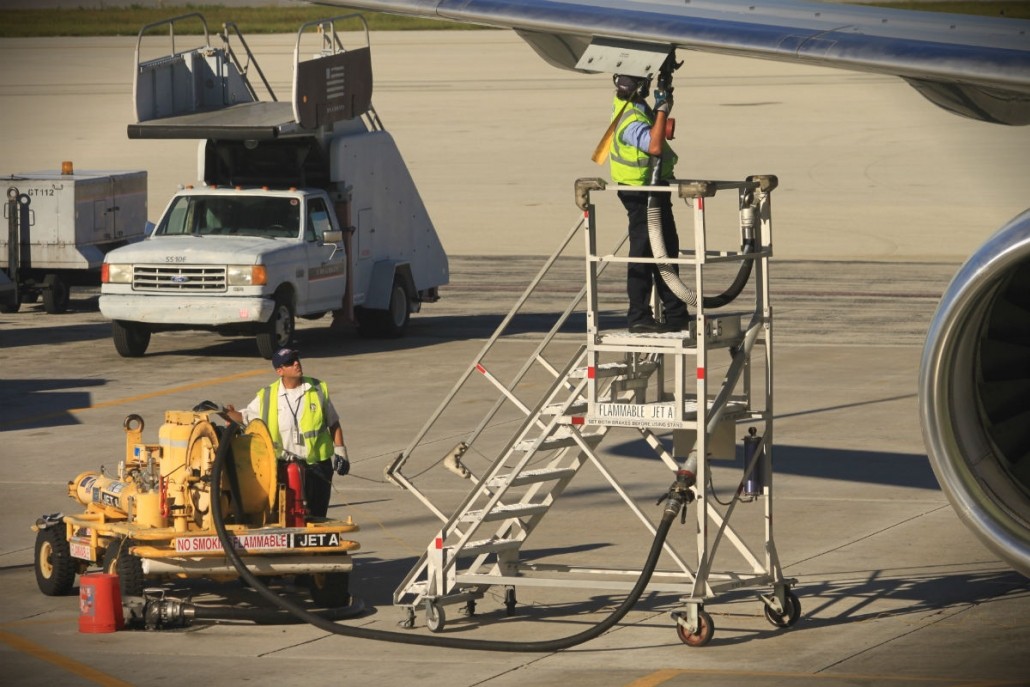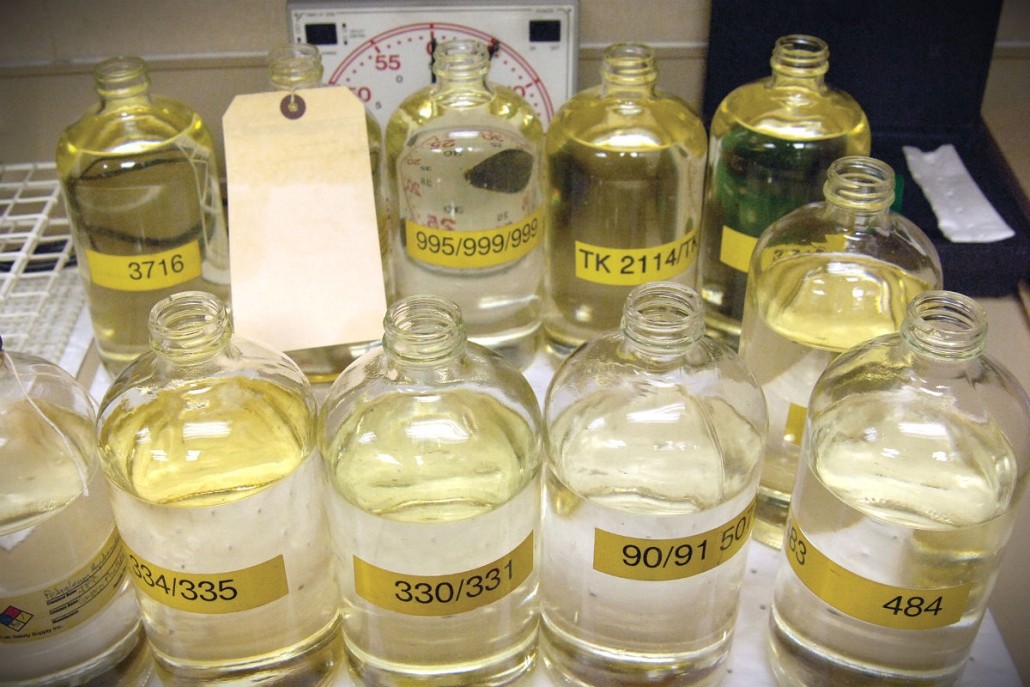Fuel is the lifeblood of aviation. A reliable supply of clean and consistent fuel is essential for smooth operations. In this three part series, we will look at the different types of aviation fuel available, the fuel efficiency of popular aircraft models, and the cost of filling your tank at different locations around the world.
Which Type of Fuel Does My Plane Require?
The two kinds of fuel most commonly used in General Aviation are Jet fuel and Avgas. As the name suggests, Jet fuel is used mainly to power jet engines, which rely on the powerful thrust of expelled air to drive the plane forward. Avgas (short for aviation gasoline) is used to power piston engines aircraft, which rely on the rotation of their propellers to generate thrust.
Many modern turboprop planes also run on Jet fuel, as they feature engines with a gas turbine which power their propellers.
Jet Fuel
Jet fuel is typically a colorless or straw-colored liquid with the two most widely used categories being Jet A and Jet A-1. The main difference between the two is the freeze point.
Jet A is used mainly in the United States. Developed in the 1950s, this fuel has a freeze point of minus 40ºC or below. Jet A-1 is defined with a lower freeze point of minus 47ºC or below, and is the most commonly used Jet fuel in locations outside of the US. Although the two fuels are manufactured to different specifications, they can be used interchangeably. A key difference lies in the additives contained within the fuel. For example, Jet A does not usually contain any static dissipater additives, whereas most Jet A-1 does.

An aircraft has its tanks replenished with Jet A fuel delivered from an underground hydrant.
Avgas
Avgas is used to power the small piston engine driven aircraft typically flown by private pilots, aviation training schools or flying clubs. The engines on these aircraft operate according to the same basic principles as the spark ignition engines found in automobiles, although flight requires far greater performance, which calls for a more high-octane fuel. There are a larger number of Avgas-fueled aircraft than Jet-fueled planes currently in service. However, as most of these tend to be small, short-range aircraft, the overall volume of Avgas sold is small compared to that of Jet fuel.
Two main Avgas grades are currently in use, these being 100 and 100LL (low lead). Avgas 100 is the standard high-octane aviation fuel used for piston engines. This fuel has a high lead content, and is dyed green. Avgas 100LL has similar make up, but with a lower lead content and is dyed blue.
Other Types of Fuel
The above are the four most commonly used types of fuel and are widely available at most destinations. A wide range of other fuels are available, most of which have specialized applications relating to extreme climates or military aviation. These include:
TS-1 is the primary Jet fuel grade available in Russia and the CIS states. This kerosene-type fuel is more volatile, but has a lower freeze point (minus 50°C) compared to Jet A-1, which is essential for operations in these colder climates.
Jet B is used in extremely cold areas such as the north of Canada, and has a very low freezing point of minus 60°C. This fuel contains approximately 30% kerosene and 70% gasoline, and is classified as a “wide-cut” fuel. Its composition makes it more flammable than Jet A, and therefore more dangerous to handle. However its lower flash point is an advantage for the cold starting of aircraft.
JP-8 can be seen as the military equivalent of Jet A-1. The fuel features some additional ingredients, including anti-icing additives and corrosion inhibitor. JP-8 is the military Jet fuel grade most commonly used by NATO airforces.
JP-5 is a high flash point kerosene-based fuel which is used mainly for military aircraft based on aircraft carriers.
Aviation Fuel Additives
Additives are chemicals which are added to aviation fuels to improve their overall performance, or to meet the specific requirements of certain aircraft models or operators. The content of different varieties of Jet fuel varies considerably, particularly between those intended for civil and military use. Additive components for Avgas tend to be fairly standard.

The additives used in aviation fuel go through stringent testing in order to ensure maximum safety and efficiency.
The quantities used are often minuscule, and only measurable in parts per million. All additives must go through a rigorous evaluation process before being approved for use.
Fuel system icing inhibitors work by reducing the freezing point of any water present in the fuel system. This helps prevent the formation of ice crystals, which can cause restrictions in the flow of fuel to the engine. These are mandatory for military jets, but are not necessary for civilian aircraft, which have built-in fuel heaters. This additive may be introduced to either Jet or Avgas at the time of fueling for smaller aircraft..
Corrosion inhibitors are added to help reduce corrosion within the aircraft’s fuel system and boost the lubricating properties of Jet fuel.
Metal deactivator may be added to fuel to counteract the effects of dissolved trace metals, particularly copper which has an impact on the thermal stability of Jet fuel. This additive is no longer in use.
Static dissipater additives help to reduce the danger of static charges which build up during the movement of Jet fuels. This additive is sometimes used for Avgas as well.
Antioxidants (gum inhibitors) are added to Avgas to help prevent the formation of gum and other antioxidation by-products. Jet fuels have a more stable composition than Avgas, however some varieties may still contain these additives depending on the manufacturing process used.
Tetra-ethyl lead is added to Avgas to enable more efficient ignition, improving what is known as the “anti-knock” characteristics of the fuel. Manufacturers are searching for a cleaner way to boost the octane rating of Avgas due to environmental concerns over the use of leaded fuel. Although several alternatives are currently in development, a reliable replacement has not yet been found.
.
Further Reading
In the second part of our Focus on Fuel, we will look at the fuel capacity, efficiency and range of some of the world’s most popular models of business aircraft. Stay tuned for the next installment!
Focus on Fuel Part Two: Fuel Requirements For Popular Business Aircraft
Focus on Fuel Part Three: Global Fuel Pricing and Availability
.
Jetex Fuel Service: The Jetex Global Fuel Network
Jetex has been supplying fuel since launching over a decade ago. Today, fuel supply constitutes one of our core offerings. We maintain an extensive portfolio of suppliers, and are the fuel provider of choice for a diverse range of operators.
All of our suppliers are subject to a stringent auditing process, with inspections carried out on a regular basis to ensure only the highest quality aviation fuel is delivered at all times.
Our Jet fuel price is highly competitive, both for Jet A and Jet-A1 variants. We can also arrange for Avgas fuel at the best prices in the market, as well as more exotic fuels if required.
If you have any questions about aviation fuel types, availability or pricing please feel free to reach out to our team. We will be delighted to assist! Contact the Fuel team today, on +971 4 212 4000 or fueldispatch@jetex.com.



